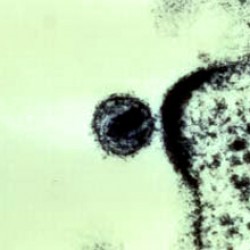Clues to HIV Protection
Clues to HIV Protection
A new study gives insight into the workings of the first vaccine ever reported to modestly prevent HIV infection in people.

HIV “budding” out of a T-cell. Image courtesy of Dr. Tom Folks, NIAID.
Most vaccines work by triggering the immune system to produce antibodies that help beat back infections. But that strategy hasn’t been successful in defeating HIV. Proteins on the viral surface mutate rapidly and change shape continuously. These quick transformations keep most antibodies from latching onto and neutralizing the virus.
In 2009, scientists reported the results of a landmark clinical trial that involved more than 16,000 adult volunteers in Thailand. Those who received an experimental HIV vaccine had a 31% lower chance of becoming infected with HIV than those who received a placebo. Since then, a consortium of more than 100 scientists has been seeking to explain why the vaccine showed a modest protective effect.
In the new analysis, researchers led by Dr. Barton F. Haynes of Duke University examined blood samples from 246 vaccinated participants, 41 of whom later became infected with HIV. The study was partly funded by NIH’s National Institute of Allergy and Infectious Diseases (NIAID). Results appeared in the April 5, 2012, issue of the New England Journal of Medicine.
The scientists found that vaccinated participants who made relatively high levels of one type of antibody to HIV were significantly less likely to become infected than those who made lower levels. These antibodies attach to the first and second variable regions, or V1V2, on the gp120 molecules of the HIV-1 envelope protein (Env). Env helps HIV fasten onto the surface of immune cells. The antibodies belong to a family of antibodies called immunoglobulin G, or IgG.
In contrast, vaccinated participants with relatively high levels of Env-binding antibodies from a different family—called immunoglobulin A, or IgA—had less protection than those with low levels. The study team hypothesizes that the IgA antibodies may interfere with protective IgG antibodies by attaching to another part of Env called the first constant region, or C1.
The researchers now plan to investigate whether high levels of V1V2 antibodies directly caused the modest benefit seen in the study or were simply linked to other, still unidentified factors. If further studies confirm the protective effect of V1V2 IgG antibodies, future vaccine strategies might aim to induce high levels of these antibodies.
“This analysis has produced some intriguing hints about what types of human immune responses a preventive HIV vaccine may need to induce,” says NIAID Director Dr. Anthony S. Fauci. “With further exploration, this new knowledge may bring us a step closer to developing a broadly protective HIV vaccine.”
###
* The above story is reprinted from materials provided by National Institutes of Health (NIH)
** The National Institutes of Health (NIH) , a part of the U.S. Department of Health and Human Services, is the nation’s medical research agency—making important discoveries that improve health and save lives. The National Institutes of Health is made up of 27 different components called Institutes and Centers. Each has its own specific research agenda. All but three of these components receive their funding directly from Congress, and administrate their own budgets.




















